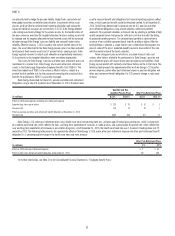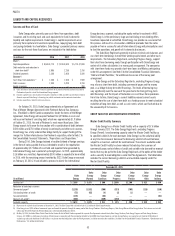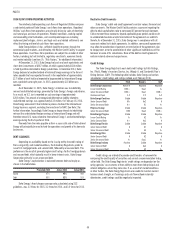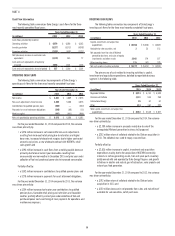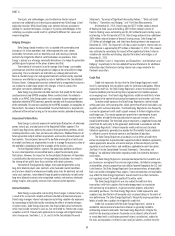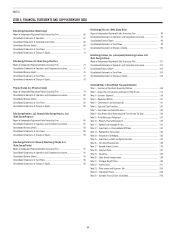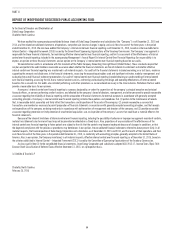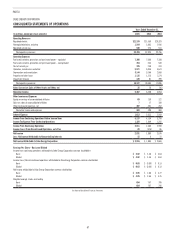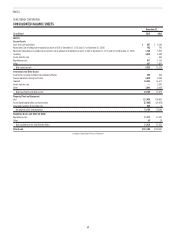Duke Energy 2015 Annual Report Download - page 82
Download and view the complete annual report
Please find page 82 of the 2015 Duke Energy annual report below. You can navigate through the pages in the report by either clicking on the pages listed below, or by using the keyword search tool below to find specific information within the annual report.
62
PART II
OTHER MATTERS
Ratios of Earnings to Fixed Charges
The Duke Energy Registrants’ ratios of earnings to fixed charges, as
calculated using SEC guidelines, are included in the table below.
Years Ended December 31,
2015 2014 2013
Duke Energy 3.2 3.2 3.0
Duke Energy Carolinas 4.7 4.6 4.4
Progress Energy 2.9 2.7 2.2
Duke Energy Progress 3.7 3.5 3.7
Duke Energy Florida 4.3 4.1 2.9
Duke Energy Ohio 3.6 2.1 2.2
Duke Energy Indiana 3.6 4.1 4.1
Environmental Regulations
Duke Energy is subject to international, federal, state and local regulations
regarding air and water quality, hazardous and solid waste disposal and other
environmental matters. The Subsidiary Registrants are subject to federal, state
and local regulations regarding air and water quality, hazardous and solid waste
disposal and other environmental matters. These regulations can be changed
from time to time and result in new obligations of the Duke Energy Registrants.
The following sections outline various proposed and recently enacted
regulations that may impact the Duke Energy Registrants. Refer to Note 4 to the
Consolidated Financial Statements, “Regulatory Matters,” for further information
regarding potential plant retirements and regulatory filings related to the Duke
Energy Registrants.
Coal Combustion Residuals
On April 17, 2015, the EPA published in the Federal Register a rule
to regulate the disposal of CCR from electric utilities as solid waste. The
federal regulation, which became effective in October 2015, classifies CCR
as nonhazardous waste under Subtitle D of the Resource Conservation and
Recovery Act and allows for beneficial use of CCR with some restrictions. The
regulation applies to all new and existing landfills, new and existing surface
impoundments receiving CCR and existing surface impoundments that are no
longer receiving CCR but contain liquid located at stations currently generating
electricity (regardless of fuel source). The rule establishes requirements
regarding landfill design, structural integrity design and assessment criteria
for surface impoundments, groundwater monitoring and protection procedures
and other operational and reporting procedures to ensure the safe disposal
and management of CCR. In addition to the requirements of the federal CCR
regulation, CCR landfills and surface impoundments will continue to be
independently regulated by most states. Duke Energy Carolinas, Progress
Energy, Duke Energy Progress, Duke Energy Ohio and Duke Energy Indiana
recorded asset retirement obligation amounts during 2015. Cost recovery for
future expenditures will be pursued through the normal ratemaking process
with federal and state utility commissions and via wholesale contracts, which
permit recovery of necessary and prudently incurred costs associated with
Duke Energy’s regulated operations. For more information, see Note 9 to the
Consolidated Financial Statements, “Asset Retirement Obligations.”
Duke Energy Ohio’s nonregulated Beckjord station, a facility retired during
2014, is not subject to the recently enacted EPA rule related to the disposal
of CCR from electric utilities. However, if costs are incurred as a result of
environmental regulations or to mitigate risk associated with on-site storage of
coal ash at the facility, the costs could have an adverse impact on Duke Energy
Ohio’s financial position, results of operations and cash flows. Costs incurred by
OVEC related to environmental regulations could also have an adverse impact
on Duke Energy Ohio’s financial position, results of operations and cash flows.
North Carolina Coal Ash Management Act of 2014
On September 20, 2014, the Coal Ash Act became law and was amended
on June 24, 2015, by the North Carolina Mountain Energy Act. The Coal Ash Act,
as amended, established regulations regarding the use and closure of existing
ash impoundments, the disposal of ash at active coal plants and the handling of
surface and groundwater impacts from ash basins in North Carolina. The Coal
Ash Act, as amended, deemed eight ash impoundments at four facilities to be
high priority and requires closure no later than August 1, 2019, with a potential
extension for closure of the Asheville impoundment until 2022. The Coal Ash Act
requires state regulators to provide risk ranking classifications for the remaining
25 ash impoundments at 10 North Carolina facilities. The method and timing
of closure of these ash impoundments will be determined by the specific risk
classifications, with closure no later than December 31, 2029.
Other than the high priority sites specifically delineated by the Coal Ash
Act, the NCDEQ has issued either preliminary draft risk rankings or has yet
to designate specific risk classifications. These risk rankings were generally
determined based on three primary criteria: structural integrity of impoundments
and impact to both surface and groundwaters. NCDEQ categorized 12 basins
at four sites as intermediate risk and four basins at three plants as low risk.
NCDEQ also categorized nine basins at six plants as “low-to-intermediate” risk,
thereby not assigning a proposed risk ranking at this time. The risk rankings
of these sites will be based upon receipt of additional data primarily related to
groundwater quality and the completion of specific modifications and repairs to
the impoundments. NCDEQ is expected to finalize its risk classifications after a
public comment process. Final proposed classifications are subject to Coal Ash
Commission adjustments and approval but may become law if the Commission
fails to act within 60 days of receiving the final proposed classifications.
Estimated asset retirement obligations have been recognized based on the
assigned risk categories or, if not assigned, based on a probability weighting
of potential closure methods. Actual closure costs incurred could be materially
different from current estimates that form the basis of the recorded asset
retirement obligations. For further information on asset retirement obligations,
refer to Note 9 to the Consolidated Financial Statements, “Asset Retirement
Obligations.”
Mercury and Air Toxics Standards
The final Mercury and Air Toxics Standards (MATS) rule was issued
on February 16, 2012. The rule establishes emission limits for hazardous
air pollutants from new and existing coal-fired and oil-fired steam electric
generating units. The rule required sources to comply with emission limits by
April 16, 2015. Under the Clean Air Act (CAA), permitting authorities have the
discretion to grant up to a one-year compliance extension, on a case-by-case
basis, to sources that are unable to complete the installation of emission
controls before the compliance deadline. The Duke Energy Registrants have
requested and received compliance extensions for a number of plants. The rule
requirements currently apply where a compliance extension was not received.
Strategies to achieve compliance include installation of new air emission
control equipment, development of monitoring processes, fuel switching and
acceleration of retirement for some coal-fired electric-generation units. For
additional information, refer to Note 4 of the Consolidated Financial Statements,
“Regulatory Matters,” regarding potential plant retirements.
In April 2014, several petitions for review of the final rule were denied
by the U.S. Court of Appeals for the District of Columbia (D.C. Circuit Court).
On November 25, 2014, the Supreme Court granted a petition for review based
on the issue of whether the EPA unreasonably refused to consider costs in
determining whether it is appropriate and necessary to regulate hazardous
air pollutants from coal-fired and oil-fired steam electric generating units.
In June 2015, the Supreme Court reversed the D.C. Circuit Court’s decision and
remanded the case to the D.C. Circuit Court for further proceedings, finding
that the EPA erred in refusing to consider costs when deciding whether it was
appropriate and necessary to regulate emissions of hazardous air pollutants
from steam electric generating units. In December 2015, the D.C. Circuit


